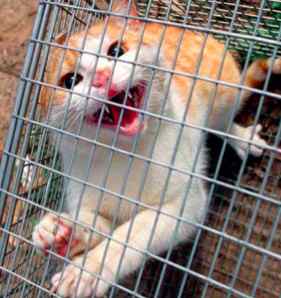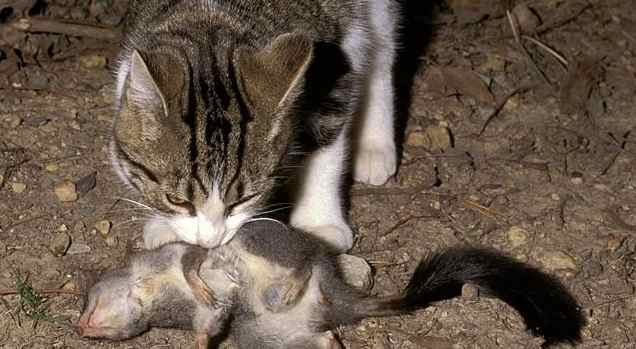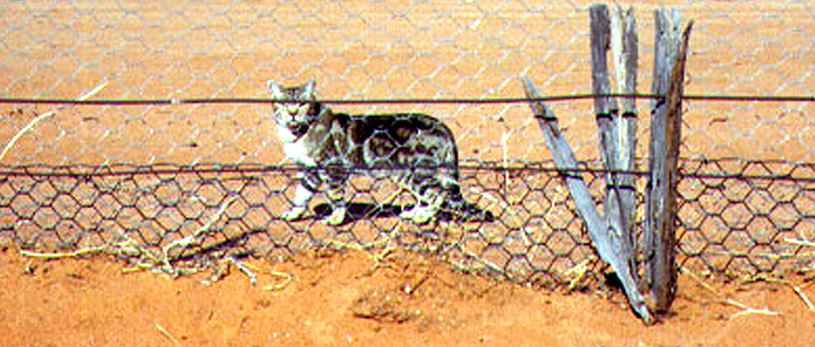On the hunt, ready to kill, she emerges from behind the rock pile at dusk; eyes gleaming green, tail twitching. As heavy as ten kilos and remarkably agile for her size, she has spent the day hiding from the sun in a den under some boulders, or maybe in a sandy hollow under some scrub. She and her kind are living anywhere and everywhere across Queensland, from the Simpson desert along the Northern Territory border to the Darling Downs grasslands.
Whiskers twitching, this night hunter is ready to track, kill and small Australian animals: she’ll eat small mammals, birds, lizards, even insects. She can travel for kilometres in search of prey and she needs no water – her thirst is quenched by her prey’s blood.
This is the feral cat.
Genetically identical to the city-dwelling domestic pussycat sitting warmly on a lap, purring and watching television, the nocturnal feral cat seems an entirely different beast.
 Brought to Australia by colonists in the 1800s, domestic cats quickly ran wild and now they are a dominant but largely invisible feature of the Australian landscape. Dr John Woinarski, a professor of conservation biology who co-wrote the seminal “Action Plan for Australian Mammals 2012” which was published earlier this year, sees the feral cat as the primary threat to a number of native species.
Brought to Australia by colonists in the 1800s, domestic cats quickly ran wild and now they are a dominant but largely invisible feature of the Australian landscape. Dr John Woinarski, a professor of conservation biology who co-wrote the seminal “Action Plan for Australian Mammals 2012” which was published earlier this year, sees the feral cat as the primary threat to a number of native species.
Natural selection, he says, has ensured that only the best hunters, the fittest and most successful feral cats survive and breed. “They are evolving,” he adds. “There’s some whoppers out there. There’s the myth of panthers in the Australian bush; they seem to be entirely huge feral cats.”
These cats run riot through Australia, Woinarski adds, because they fill a niche that on other continents is already filled by comparable predators. “Australia has a gap in many of its predator assemblages; feral cats can monopolise much of that space”.
With a population of perhaps as many as 20 million feral cats across Australia, the common house cat has been classified as a class 2 pest in Queensland (along with a range of other feral animals – dogs, goats, pig, rabbit and deer).
The feral cat been blamed – in conjunction with foxes – for the extinction of more than 20 species of small native mammals, including the desert bettong, the desert rat kangaroo, the pig-footed bandicoot, and the lesser bilby. Now ecologists can see the signs of another wave of extinctions underway, mostly in Australia’s north and particularly in the Kimberley and the Northern Territory, and mostly because cats have run wild.
Voracious eaters, feral cats can mow through Australian natives at speed, by some estimates killing and eating an average of five animals each every night.
One feral cat, shot in South Australia, had a belly filled with three striped skinks, one lined earless dragon, one smooth earless dragon, three bearded dragons, 24 painted dragons, a house mouse and a zebra finch. The belly of another enormous cat, shot at Astrebla Downs national park north of Birdsville in western Queensland earlier this year, was filled with partly-digested and extremely endangered baby greater bilbies. Rangers in the park have found about 120 bilbies, of an estimated tiny and struggling population of roughly 700, in the stomachs of cats shot in the park over the past 18 months.
It’s becoming increasingly clear that feral cats have to be controlled or many more threatened Australian species will dwindle and die out entirely, at least on the mainland. But the battle will long and hard: wily feral cats can be difficult to trap and because they are largely nocturnal, they can be hard to shoot. They usually disdain baits unless there is almost nothing else to eat and they can repopulate at speed.
 One possible solution to the feral cat menace has been identified in Queensland’s Cape York, where healthy populations of dingos are thought to keep cat numbers down and where native mammal declines are less dramatic. “There’s an argument, where you’ve got more dingos, cat impacts are far reduced,” Woinarski says.
One possible solution to the feral cat menace has been identified in Queensland’s Cape York, where healthy populations of dingos are thought to keep cat numbers down and where native mammal declines are less dramatic. “There’s an argument, where you’ve got more dingos, cat impacts are far reduced,” Woinarski says.
Native to Australia, dingos across most of the nation are now deeply interbred with feral dogs and, like the feral cat, classified as a class 2 pest: which means landholders are required to control them. Although dingos are protected in national parks, elsewhere they are often baited. Feral dogs and dingo-crosses are now wreaking havoc in parts of Queensland, attacking sheep and even smaller cattle as well as wallabies and feral cats: wild dogs are yet another example of introduced species running riot.
Some authorities are using exclusion fences, to corral native animals in a small area and keep feral cats and wild dogs and foxes prowling outside. But Queensland largely doesn’t use exclusion fencing, perhaps partly because of an unfortunate experience a couple of years ago in Currawinya national park, 170 kilometres south-west of Cunnanulla and near the NSW border: the exclusion fence was damaged, and inevitably the cats got in and killed and ate a substantial number of endangered bilbies.
Exclusion fencing is regarded by many as a frightening last resort, conjuring the image of handfuls of native animals clustered in tiny land-islands of safety, while outside the fences, across the mainland, introduced predators hunt the remaining natives to near-extinction.
John Wharton, mayor of Richmond Shire in north-west Queensland, has seen feral cat populations explode when the conditions are good. Comprising 28,000 square kilometres of cattle properties, located in the arid country between Townsville and Mount Isa, at one stage Richmond shire was heaving with feral cats.
“It was shocking,” he remembers of the last feral cat plague. Ten years ago the shire introduced a bounty for cats: every cat tail brought in was worth $10. Richmond is one of a handful of Queensland shires that at various times have offered a cat bounty, others include Carpentaria on the Gulf, and McKinlay shire, around Julia Creek.
“We were the first shire in Queensland to put a cat bounty on,” Wharton says. “We did it under our local law and the Queensland government, Rod Welford was the minister at the time, he wrote me letters telling me how terrible it was, how bad we were.” Wharton responded that the Shire was simply trying to protect the region’s native animals, and the Shire’s roughly 1,000 residents nearly all agreed with the policy.
These days, there’s still a cat bounty in Richmond, but it’s been reduced to $5 a tail. Richmond began the plan with a $20,000 bounty allotment in the budget, Wharton adds, and that went in the first six months – “so we had to slow down a bit”.
The plague numbers have fallen now the good years are over, but the locals remain vigilant. “There’s still plenty of cats around, they do need to be controlled,” Wharton says, arguing that Australia needs to seriously deal with the problem. “We need to harden up sometimes and think about the big picture, think about the whole environment we live in.”
Yet bounties may be little more than a sop to concerned residents: there have been five Australian reviews of bounties since the 1970s, and each of them has found that bounties are counter-productive compared with longer-term controls.
 University of Queensland biologist Dr Diana Fisher says feral cats present a complex problem. “Hunting, baiting, trapping, bio-control, exclusion zones – none of those really work very well,” she says. “That’s really why we only have success (getting rid of feral cats) on islands. Cats don’t really take baits very successfully; they like to eat live, moving things. You can bait foxes and dogs and other feral species, but cats are very difficult to bait. They also don’t necessarily use roads, so putting baits out isn’t so straightforward. Shooting isn’t going to find all of them, unless you’re in an enclosed space, like an island.”
University of Queensland biologist Dr Diana Fisher says feral cats present a complex problem. “Hunting, baiting, trapping, bio-control, exclusion zones – none of those really work very well,” she says. “That’s really why we only have success (getting rid of feral cats) on islands. Cats don’t really take baits very successfully; they like to eat live, moving things. You can bait foxes and dogs and other feral species, but cats are very difficult to bait. They also don’t necessarily use roads, so putting baits out isn’t so straightforward. Shooting isn’t going to find all of them, unless you’re in an enclosed space, like an island.”
Even if there was an easy way to kill individual feral cats, the species can rapidly repopulate when conditions are good. In a productive year an adult female cat can have as many as three litters, each with an average of four kittens. Fisher points out that past studies have found “unbelievably huge densities of cats” in the Channel Country in the state’s west in the years after big rains when there is plenty of prey around.
For his part, RSPCA Queensland’s CEO Mark Townend worries about the suffering of cats that are not shot cleanly by bounty-hunters. He agrees, though, that feral cats must be controlled; whether by trapping or baiting or shooting. “We don’t mind what controls are used,” he says, “as long as it’s humane”.
Townend has spent a long time pushing Queensland to make and enforce rules to control pet cats. Experts largely agree that Australia’s populations of pet cats bleed into feral cat populations. Unwanted and abandoned kittens, cats that simply stray or run wild: there is movement from the pet cat population to the world of feral cats. So effective management of pet cats is essential.
“I’ve been banging my head against the wall,” Townend says with frustration. “There’s an issue there, but governments continue to ignore it. The government resists introducing simple desexing legislation on sale or transfer. The current government in Queensland says it’s more red tape, and they’re anti red tape.”
Dr John McVeigh, the state’s minister for agriculture, fisheries and forestry, says the Queensland government promotes responsible pet management, and requires all pet cats to be micro-chipped. But, he says, “state-wide mandatory cat registration was repealed to reduce red tape and empower local councils to decide on cat management strategies to best suit their community’s needs”.
Meanwhile, his ministerial counterpart, Queensland’s national parks minister, Steve Dickson, waxes passionate on the disaster of the feral cats invasion.
“The challenges of managing feral animals across Queensland are huge,” he says. “Our national parks are home to many species on the brink of extinction and their survival relies on us taking charge, and protecting them from these pests. It’s absolutely heartbreaking to hear about a decline in our native animals, and then see a feral cat with a belly full of bilbies or nail-tail wallabies.”
Queensland has feral animal control programs running in national parks across the state, mostly trapping and shooting, along with some poison baiting using the traditional 1080 poison bait, which has been used for decades to control cats and foxes.
Cats are controlled along with wild dogs, foxes and pigs in national parks such as Astrebla Downs and Currawinya, specifically to protect endangered bilbies, and in the Avocet Nature Refuge and nearby Idalia national park (south-west of Blackall) as a measure to shield the bridled nail-tail wallaby. Cat control programs are also underway in Chillagoe-Mungana Caves national park, west of Cairns; Curtis Island national park, off Gladstone; Carnarvon national park, south of Emerald and Taunton national park, west of Rockhampton.
Dickson insists the battle against the feral animal invasion is being won, with numbers declining and “an improvement in the local native populations and eco-systems”. Ecologists shrug and look sceptical when asked about wins in the battle to sustain native species.
Meanwhile, the idea of shooting or poisoning feral cats is often met with fury from pet-lovers. Cat advocates (the “moggy-lobby” according to some) are upset that feral cats have recently emerged as the demon in Australia’s extinction story.
According to Michelle Williamson, a blogger, commentator and no-kill advocate, government agencies such as the CSIRO developed poisons for dogs and foxes; then, when fox numbers were reduced, feral cats spread into the predator vacuum, and now the official agencies have begun developing poisons for cats.
“They created a problem – killed the dingos, so the foxes got a hold, then killed the foxes – and now they’re targeting cats,” she says. “The government has given them (a bio-tech company, amongst others) millions of dollars to develop this poison. It’s genius! Create a problem – become the solution. Repeat. It would be hilarious, if it wasn’t killing millions of animals in the process.”
Williamson is right, there are specialised cat-baits in the pipeline: and many experts hope they will be at least a part-answer to the feral cat problem. One is called Curiosity and it is considered to be more humane than 1080.
While usually effective, at least on foxes, 1080 is only reluctantly endorsed by the RSPCA. Still, for years there have been few other potent baits available and, importantly, many native carnivores, particularly in western Australia, have a tolerance for 1080. So RSPCA leaders, including Queensland’s Mark Townend, concede there is a need to use 1080, often spread via air-drops, to control the inexorable march of introduced pests like feral cats and foxes. “There are certain issues with 1080,” Townend says, “but there’s no alternatives at the moment, and it has the least amount of fallout for other (native) animals”.
Curiosity baits rely on a toxin that halts the flow of oxygen to the blood. Yet to be fully licensed, Curiosity has been extensively tested and an official report says the results are “analogous to the animal going into a sleep from which they do not wake up”. The RSPCA says it “believes the cats die a humane death” when they eat Curiosity baits.
Developed by various government departments in conjunction with a bio-tech company at a cost of $4.1 million, Curiosity baits have also been specifically designed to minimise the risk to Australian native carnivores. Cats don’t have molars, and they usually rip and tear flesh before swallowing it in chunks.
A meaty little sausage, the Curiosity bait contains a hard pellet of toxin, which is swallowed whole by feral cats. Native carnivores, on the other hand, apparently nibble and chew their food and they usually reject the pellet. Unfortunately cats are usually reluctant to take baits when live prey is plentiful, but experts believe Curiosity could be effective in lean seasons.
Looking to the future, it seems biological control could be an important way of limiting the spread of feral cats. Yet many Australians who have pet cats would find the introduction of a new disease difficult to stomach, especially if it made cats suffer and if there was a chance it could spread into the domestic cat population.
CSIRO research director Dr Andy Sheppard has worked on the bio-control of a range of introduced pests: everything from fireweed to rabbits and, of course, cats.
Disease is a useful weapon, he points out, and it has been successfully used in Australia to control rabbits. Elsewhere in the world, a disease in the form of the infectious feline enteritis virus has been used to curb a feral cat population on a South African island in the 1970s. All descended from a handful of pets brought to the island in the 1940s, the Marion island feral cats numbered in the thousands by the 1970s. In 1975 alone, these feral cats killed and consumed an estimated half a million birds.
“Marion Island is the only place they’ve used a cat disease to control feral cats and it was reasonably successful, although they did have to use hunting and other methods to finish them off,” Sheppard explains. “But it was successful because the cats had no innate immunity to the disease.”
Still, the disease was agonising for the feral cats living on the remote island and, at the same time, the few surviving cats kept breeding and the cat population soon began to rebound.
Hunters were repeatedly brought in to eradicate the remaining cats; then traps were used and by 1991, tiny Marion Island (19 kilometres long) was finally declared cat-free. Hunters and dogs were also used to rid Australia’s Macquarie island (34 kilometers long) of feral cats, a massive undertaking lasting from 1985 to 2000. Now work is underway to eliminate feral cats from Christmas island, but that too, will be a long and slow process.
To tick all the boxes, and get scientists, environmentalists and cat-lovers on side, scientists will need to come up with a painfree, non-lethal, rapidly spreading disease that effectively neuters cats; and one that’s confined to the common house cat in Australia (to limit the danger of transmission to other feline species, including tigers and lions abroad). This is an almost impossible ask, most experts agree, but research on feral cat control continues.
“Biological control of cats,” Sheppard says, “that’s the holy grail.”